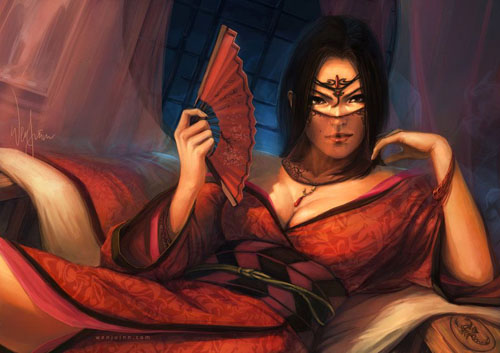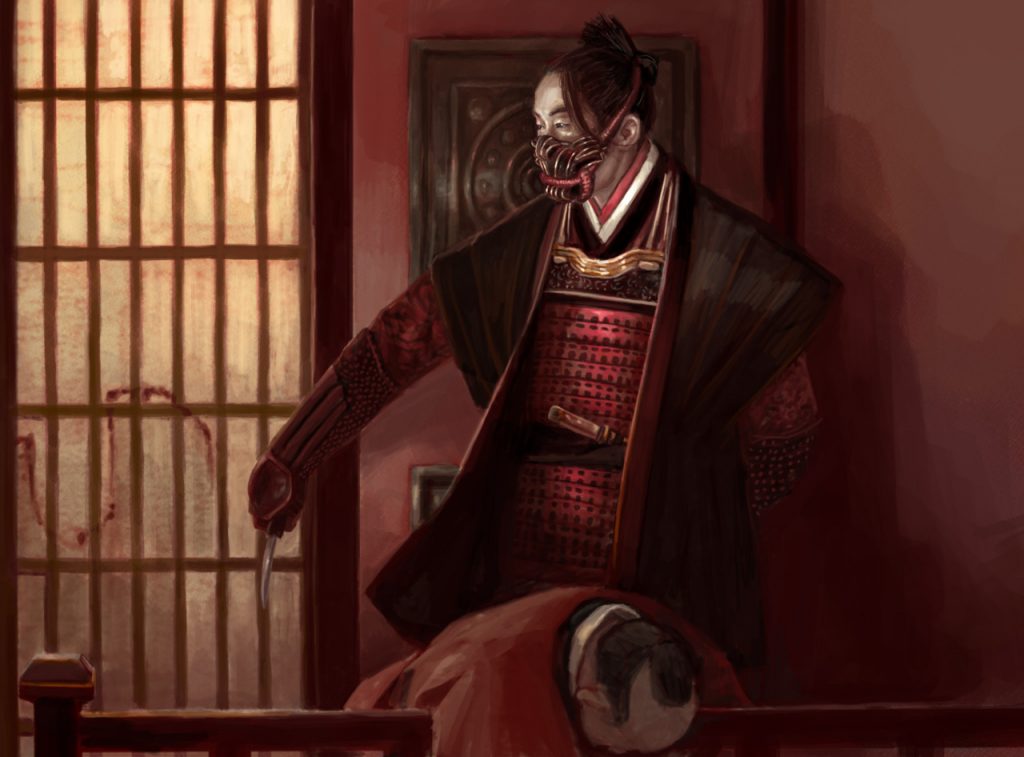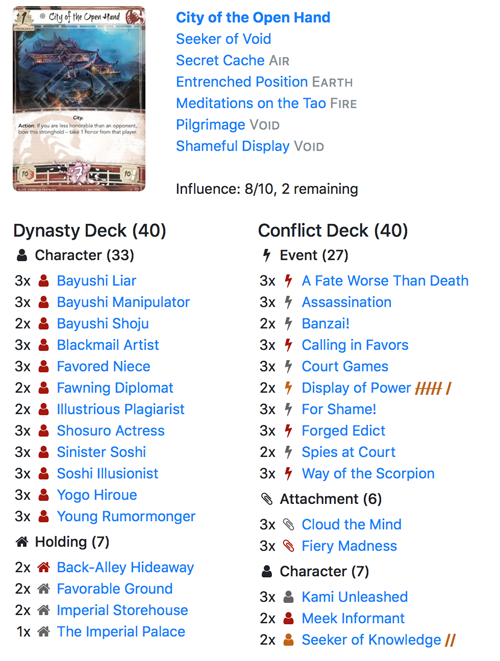Defensive Dishonor Theory
The Scorpion clan are having a stellar Kotei season, with a significant portion of their success due to Fro Top’s excellent switch deck focused on Conflict Characters and card draw. In this article, I’m going to talk about a different style of deck, one that focuses on a control and denial strategy. This strategy forces both players to draw fewer cards and thus starves more aggressive decks of the fuel they require to close out the game. A deck based on this theory saw great success at Gencon and Worlds, making top of clan for both events.
I Banzai! your Banzai!
The theory behind this deck can be summed up as “I don’t Banzai! to take your Province, I Banzai! to counter your Banzai!”. In general, the intent is to play in as reactive a manner as possible, using your cards as answers rather than playing them aggressively. Because you do not need to spend the extra cards to destroy a Province, you are satisfied passing the moment the conflict is in your favor.

The Inherent Card Advantage of Defending
The basic idea behind card advantage is that one player has more cards in hand and in play than their opponent does, and thus more options and opportunities. In general players often only consider cards in hand or cards with abilities on them when considering card advantage in L5R. However, there are a few other sources of considerable card advantage for certain decks.
When an attack is declared, the attacker must assign at least one character. That is generally 1/3 of their available characters, meaning that attacking has a significant resource cost. The opponent’s first line of the defense is Provinces. Each Province has a strength value, with 4 being the most common. This means the average 2 to 3 cost character isn’t in a position to take the Province solo. Many Provinces also have additional text or abilities that generate more value. The trade-off for this is getting to resolve a Ring. Even if the attacker fails to take the Province, they will still resolve a powerful effect that will usually compensate for the assigned character.
If the attacker wants to destroy the Province, they will generally have to spend an additional card, such as assigning an additional character or using a skill pump like Banzai! At this point, the attacker has spent two cards to achieve his objective. If the defender assigns a character or plays a defensive card such as Mirumoto’s Fury, that will usually prevent the Province being destroyed. Unless that is, the attacker plays an additional card to compensate. Thus, it is easier for the defender to generate card advantage from an attack that aims to destroy a Province.
#AlwaysBidOne
First things first, the hashtag should be #AlwaysBidOneUnlessAnotherValueIsMoreAppropriate, but it doesn’t roll of the tongue quite as well, and the shorter version gives you an idea of the core principle – you want to bid low, for two reasons. You want to steal honor from your higher bidding opponents, and you want to force a game state where both players are drawing in small numbers. There are times when you’ll bid higher, often when you’re on the same honor as your opponent and want to use the Stronghold, but get used to having no cards in hand.
The first few games of bidding one can be intimidating. Your opponent will be playing with a hand almost twice as big. You’ll feel like they’re going to have an answer for everything, and sometimes they will. But in time, you will be able to survive the rough first turns with minimal impact – even losing a Province doesn’t matter too much most of the time. A player who bids 5 to your 1 on turn one will generally head into turn two on 5-7 honor. That isn’t quite in the danger zone, but it’s close enough that they have to start playing much more conservatively than most players are used to. Undefended attacks become a painful honor loss, instead of 10 or more cards they’ve got five and all those 1 point losses from dying dishonorably look a lot scarier.
The psychological edge can be significant. When both sides are down to just three or four cards, the player with more experience in that scenario has an advantage. They are better able to focus on what matters and what tricks they still have available rather than how few cards they have.
Advise on what you should bid on turn one varies from player to player. I personally always bid 1, as I feel it accelerates the rate the game gets to the point where I’m winning. This approach does make the early game a little riskier. Others bid 5, setting themselves up for a smoother early game at the cost of delaying the dishonor lock an extra turn. Both options are equally viable. It is important to use the method you’re most comfortable with but do test both options.
Working 9 to 5
By keeping the overall amount of Conflict cards in game low, the value of abilities on the board increases. For Scorpion, this means cards like Sinister Soshi, Soshi Illusionist, and Shameful Display can swing battles by themselves. The card draw on Imperial Storehouse and Secret Cache generates more value. Ring of Earth hits harder.
Being down 4 Conflict cards at the start of the Conflict Phase on turn one is intimidating, but it’s not an insurmountable deficit. If your opponent attacks a 4 province strength Province with a 3 skill character, they’re already going to have to spend one card to take the Province. That means it’s 8 to 5. If you defend with a 2-3 skill body, they’ve got to spend a second, putting it at 7-5. That gap is a lot more manageable, and that’s without factoring in the defensive ability of your Province. Likewise, a successful Earth Ring (often the priority in the early game) results in a more significant swing in resources than it would if the hand sizes were 14-10.
When this deck attacks, it rarely attempts to take a Province, but instead just aims to trigger Ring effects. That means the attacks have as low a cost as possible, saving resources for the defense. If your opponent does start spending cards to defend, then you are often in a position in the early game to let them win the Ring and drain their resources. Identifying a soft target Province to attack is important in this scenario – you don’t want to be repeatedly attacking into a Shameful Display. If they have a Meditations on the Tao and you can attack with characters with no Fate on them, then you can keep claiming Rings Conflict after Conflict with minimal impact from their Provinces.
It’s common with the deck style to “sacrifice” the first turn, focusing on defending rather than attacking. This can seem wasteful until you think about what you’ve achieved in that turn. In general, your opponent will be down 4 honor, and 3-4 cards from hand. Even if you had to spend 2 cards to successfully defend, your opponent is now at around 7 honor, failed to achieve anything on the first turn and has lost much of their hand advantage.
Rings
Proper Ring choice is probably the most important element of the deck. With fewer options in hand, you’ve got to make sure every attack counts, whether from the Ring you’re triggering or the resources you’re forcing your opponent to dedicate to the defense. In the early game, the focus is on resource control and denial – the Earth ring to draw/discard cards and the Void ring to discard characters. The Earth ring helps massively with the hand disparity, and you cannot afford to be hit by it yourself. The Void ring is a useful tool to help keep the opposing board from growing too large, and taking out dishonored targets early to get an extra honor loss in.
As your opponent drops in honor, the Fire and Air rings become more valuable. The Air ring, in particular, is important as you want to deny it for your opponent. That said, the Fire ring is generally the preferable ring if all other things are equal – dishonoring a target still causes a 1 point loss, and the reduced stats can make the rest of the turn easier.

Time, the greatest enemy
As much as not aiming to take Provinces can be leveraged into an advantage, it does have one significant drawback – destroying Provinces is the easiest way to earn tiebreaker points. In most games, you can be assured you’ll have the most honor (or else something has gone very wrong), so it’s unlikely you’ll be 5 points behind when time is called. This means you’ll have the option to continue the game until the end of the turn, but if you can’t finish it win in that time then you’ll likely lose on points.
In my experience, once you’ve got the hang of the deck most wins will occur turn 3, or on your first attack of turn 4. If you miss the ‘window’ to win it can be hard to finish out the game as your opponent hovers around 3 honor and continues to slowly take Provinces.
There are two basic ideas that can help mitigate the Tie Breakers situation somewhat, both of which require you to get a good read of the game state, and thus have experience from testing the deck:
- If you are getting close to time and you’re not confident you can win by dishonor, it is always worth considering a high bid. The sudden burst of cards can catch your opponent off-guard and help you even out the Tiebreaker points.
- If you swing into a particularly dangerous Province, such as a Shameful Display, sometimes it can be worth taking it – it protects you from Talisman of the Sun and can help with tiebreakers if needed.
Check out this sample decklist and a guide on how to play it on FiveRingsDb.com.





13 Replies to “Defensive Dishonor Theory”
Fantastic article, Jon.
Pretty cool !
Would love more articles like this to understand card choices in deckbuilding.
What do you think of the Covert dishonor going around?
Thanks for sharing !
I would like to try Crab splash for dishonor Covert + Watch Commander. Btw, has anyone tried Contingency Plan?
Crab is definitely a solid splash choice for the deck, for exactly the cards you laid out. I tried Contingency Plan in the deck, and the window of usefulness on it is much too low to be worth the slot unfortunately.
Hi,
thanks for another piece of fantastic work! The crab Winner Michail (Düsseldorf Kotei) was doing the same, always bid 1 and just starve you out.
from my scorpion experience it is sometimes just better to break a province to get the victory points in a tournament environment . So bid 5 first (even 6 with that Manipulator) and starting from round 2 you go for bid 1. This will make sure you have enough answers and you just begin the choking one turn later. If you run into time, the break will keep/bring you in magistrate stage
Superb analysis and deck building to match your objectives.
What is fearful in such decks is that in the qualifying rounds (when you dont necessarily know your opponent’s decklist) you must find a way to deal with both scorpions : those who will bet 5 at first and those who will bet 1.
Probably 3 is a way to wait for a better insight about the kind of scorpion you are facing but at the same time, with some badluck, this 3 might also turn into being your actual losing move. Quite frightening 🙂
Plus, not being an English native, i now learned about the Catch-22 novel. Thanks for that too ^^
Fantastic article! Keep up the good work. 🙂
So I did a funny thing, I took this theory as a Crane and applied it to a game I played tonight. I played through to the end of T2 using this Scorpion strategy of bid 1 and make the opponent work, thinking that I would have to change to a more “traditional” Crane style on T3. It was working amazingly well, my opponent was baffled, he was down to 4 honor and I was just using chud to scout and stop breaks plus I had good card advantage due to his overplaying and my card draw actions. I had banked up some amazing fate (16-18) for the T3 start, had all new cards ready to flip on my provinces, we were 1 broken province each, I had the favour and despite my empty board, life was good …playing like a Scorpion. Then we flipped the cards….I had 3 holdings and Asahina Artisan…I drew 5 (luckily he did too) looking for some characters…none. Life shattered and I lost in T4, all my heavy hitters were in the last half of my deck. I knew I didn’t have the right cards to take this one all the way to the end, so that switch from dishonor to conquest on T3 was critical until it swung the wrong way (the Kami were obviously displeased). A look in my decks after showed that had I survived until T5, I probably could have taken it but that is nothing but mist on the horizon. High risk, high payoff…didn’t work this time but I think I have a strategy in my pocket for when people are not expecting Crane to do bad things.
Is Kachiko considered to be too expensive?
Thanks for the read Bayushi Akai! Reading over the article I can tell you have played quite a few games of Scorpion dishonor. I really enjoy the impact Scorpion can get out of Seeker of Knowledge, I have had success running her since the core set. I 100% agree the most important thing is making your opponent spend more to attack and minimizing resources to gain ring effects. I used to bid 1 always on first turn just like you are suggesting.
However, even for the reasons you listed I think it is all the more better to bid 5(or even 6). I think getting the earliest possible use out of your stronghold is important. The comparison in honor vs cards is the part that I had to debate, if you give your opponent a foot hold early to be able to deal with any sort of board state you give them they won’t be afraid to bid 1 for the rest of the game. So if they start with 4 more cards than you, they can easily take provinces with their card advantage. Bidding 1 is risky for sure; you put a lot of pressure on your dynasty deck to help guide you through the first turns, the partial mulligan helps but you can always get a bad flip.
My point being is that the dishonor control isn’t just about controlling one resource, but all of them. At some point we could assign values to each resource, I like to translate them into honor. I say fate is somewhere around the value of 2 to 1 honor(2 fate: 1 honor). Leaving cards in hand, which is slightly different; obviously 1 to 1 makes sense for cards, since we literally pay an honor for each. But cards have some sort of value based on how many our opponent has. If you have more cards in your hand, your opponent will feel it and they will be pressured to want to spent fate to draw cards. Setting people up for the rest of the game being an uphill battle where they are constantly worried about cards and honor. Your board state should never suffer as a defensive dishonor, not that yours does.
I try holding onto everything on first turn while bidding high, buy only what I think I will need to hold off a province, maybe a 1 cost or Conflict character to sneak a ring of fire, save fate cards, and spend all my honor I can. Obviously there are tons of strategies, thanks again for the read!
This is informative content …
I added your web-site into my favourites!
Keep up good work! Excited for future updates!
Paul